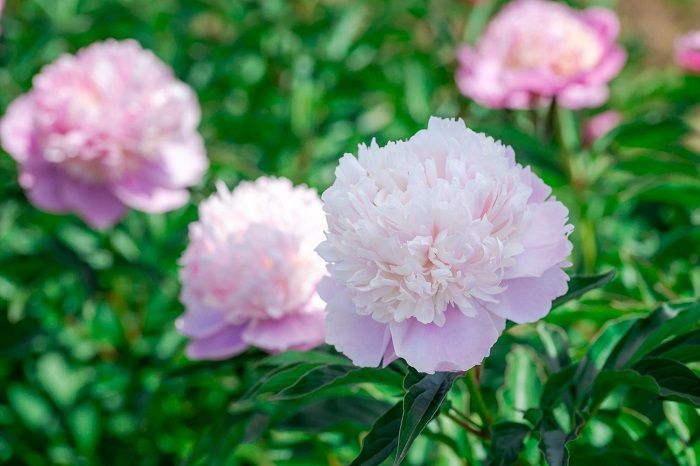Welcome to the wonderful world of peonies, where beauty blooms at every stage. Peonies are loved for their beauty and low maintenance. They go through different stages of growth, and it’s important to know them to help your peonies thrive.
In this article, we’ll explore the following Peony growth stages:
- Bud Swelling
- Germination
- Leaf Opening
- Extension
- Bloom Bud Enlargement
- Bud Coloring
- Flower Opening
Each stage has its own challenges and rewards, and we’ll guide you through caring for your peonies at every step.
Whether you’re new to gardening or an experienced enthusiast, our easy-to-follow guide will give you the knowledge and techniques you need to get the most out of your peonies.
Get ready to be amazed by the wonders of peony growth stages and learn how to create a garden full of beautiful blooms year after year.
Let us be your trusted companion on this exciting journey to peony perfection!
Post Contents
What is Peony? Basic Information
This concise information table allows you to explore a wide variety of Peonies in a quick glance. Discover the beauty and allure of Peonies in a single glance.
| Basic Info | Peony |
|---|---|
| Kingdom | Plantae |
| Order | Saxifragales |
| Family | Paeoniaceae |
| Genus | Paeonia |
| Native to | Asia, Europe, Western North America |
| Types | Herbaceous, Tree, Intersectional |
| Flower Features | Large, showy, fragrant |
| Flower Colors | Various (white, pink, red, yellow, coral) |
| Leaf Features | Compound leaves with lobed/divided leaflets |
| Lifespan | Perennial |
| Cultural Significance | Symbolizes wealth, honor, prosperity |
| Medical Uses | Potential anti-inflammatory and analgesic properties |
| State Flower | Indiana, United States |
Understanding the Peonies:
Scientifically referred to as Paeonia, the peony is one of the genera of approximately 30 species of flowering flowers from the Paeoniaceae family. It is popularly recognised for generating large colorful plants.
Peonies are well-known, beautiful, old style perennials determined broadly speaking on flower gardens, and exist from late May to June.
They develop adorable plants, specifically whilst you narrow them. The blooms appearance large, tender, soft, silky, and colorful.

Peonies are of 3 distinctive groups: the herbaceous Eurasian peonies, the Asian tree or mountain peonies, and the North American peonies.
The herbaceous peonies are perennials that may develop as tall as 1 meter (nearly 3ft). They are recognised for generating large, glossy, and extremely partitioned leaves developing on annual stems which might be created through fleshy rootstocks.
During the overdue spring and sunrise of summer, they develop large double plants that are available in white, pink, rose, and purple color.
The properly scented Chinese peony and the European peony have produced a maximum of the well-known lawn peonies so far.
The Chinese peonies, in particular, have produced approximately masses of grown types just like the Japanese types, with a unmarried or rows of petals soaring round a collection of half-shaped petals withinside the middle (petaloid stamens).
Peonies are not often cultivated from seeds besides for breeding programs, because it takes approximately years earlier than the seed can germinate. Peonies thrive in barely wet, well-tired soil.
The potted herbaceous peonies are pleasantly planted through digging a hole, putting off the flowers from the pot, and setting the plant in the hole to permit the pinnacle of the base ball to stage up with the soil.
Peonies rarely produce plants for their first 12 months after cultivation. It can absorb for a few years for it to absolutely produce large bountiful flowers.
However, straight away after the peony plant has begun out generating flowers, you could assume it will provide long-lasting, fabulous blooms. Peonies rarely require separation!
Also Read: 5 Bell Pepper Growing Stages! [An Ultimate Guide]
The 7 Peony Growth Stages:
The peony has 7 major growth stages. As we have discussed above, because peonies can take nearly three to four years to absolutely mature flowering flowers, they want to skip through seven distinctive growth stages or degrees.
Meanwhile, the primary 12 months of its growth is hinged on root manufacturing and germination. If the primary 12 months produce plants, they will be smaller and feature distinctive bureaucracy and colorings from the mature ones.
The following are the seven successive peony developing and growing stages with their developmental activities:
Stage 1: Bud Swelling Stage
The first peony developing level happens whilst the buds swell after there is an increase in temperature and water absorption. This level gives the fleshy and vivid appearance of the outer scales.
After that, it loosens up but stays folded. At this length, peony regrowth starts after the frost season.

However, the timeframe among the length of temperature boom and bud swelling differs with every cultivar. But, the cap potential of the bud to skip through dormancy to swelling up determines the time it receives to antithesis for every cultivar.
Stage 2: Bud Germination and Shoot Appearance Stage
As the buds continue to swell, the peony plants enter the germination stage. This is a crucial period where life stirs within the tightly bound buds. Beneath the surface, intricate processes unfold, unseen to the naked eye.
Within the protective layers, cells divide, nutrients are absorbed, and the plant’s energy is directed towards its upward growth. It’s a silent but remarkable transformation, as life force surges through the plant, readying itself for the grand reveal.
Stage 3: Leaf Opening Stage
As the stems and leaves keep growing in the direction of maturity, the petioles start to elongate, which ends up in the commencing of curved leaflets and the emergence of the flower bud.
Once this level ends, the stem grows as much as ⅔ to ⅘ feet tall, that is by chance the final peak it’s going to get to. Several instances for the duration of this level would possibly witness the arrival of early flower abortion.
Stage 4: Leaf Extension Stage
During the extension stage, the peony plants experience rapid growth, reaching for the sky. Their stems elongate, as if yearning to touch the heavens. This growth spurt is a testament to the plant’s resilience and vitality.
With every passing day, the peonies transform into majestic beings, their stems standing tall and proud, bearing the weight of their blossoms-to-be. The extension stage is a visible reminder of nature’s unwavering determination to reach new heights.
Stage 5: Bloom Bud Enlargement Stage
As the extension stage progresses, the peony buds undergo a remarkable transformation in the bloom bud enlargement phase. The once small and compact buds swell further, their size expanding dramatically.

It is a period of remarkable anticipation, as the buds grow plump and heavy with the promise of radiant flowers. The energy stored within the buds is palpable, filling the air with an aura of excitement. Each day brings the buds closer to their moment of glory.
Stage 6: Bud Coloring & Maturity Stage
With the approach of blooming time, the peony buds enter the enchanting stage of bud coloring. It is during this phase that the buds start to exhibit hints of their forthcoming beauty.
Shades of pink, coral, or creamy white begin to tinge the outer petals, as if nature is delicately adding brushstrokes to a masterpiece.
The vibrant colors gradually intensify, transforming the buds into miniature works of art. This stage is a visual feast for the eyes, as the peonies prepare to unveil their radiant blooms.
Stage 7: Flower Opening Stage
This stage is the very last stage of the peony growing stages or degrees. It is the length whilst the petals open up, and the plants begin showing the widespread decorative capabilities of the cultivars.
Note that the potential of the herbaceous peonies to flower beneath compelled instances differs in step with the cultivar and isn’t primarily based totally on their blooming potential in ambient developing situations.
Related: 9 Watermelon Growing Stages: [How it Grows + Care Tips]
Best Conditions for Peony Growth:
As we mentioned above, peonies are most of the pleasant famous perennials. They are favorites of most people because of their adorable flowers. They have fantastic capabilities like large, tender, soft, silky, and colorful flowers. However all these features can be opted only if the plant is cared well.

If peonies are given all the possible pleasant care situations, they will always produce the pleasant and beautiful, fragrance-rich, and pleasant yield that you always desire.
Therefore, despite the fact that forgotten peonies may also someway continue to exist on their own, it’d be pleasant and more healthy in case you pick a pleasant developing area for them. Use a pleasant soil with rich nutrients and wet situations.
How to Speed Up Peony Growth?
To help speed up peony growth, you can follow these tips:
- Planting Location: Choose a well-drained and sunny location for your peonies. They prefer at least 6 hours of direct sunlight each day. Good drainage helps prevent waterlogging, which can hinder growth.
- Soil Preparation: Prepare the soil before planting by adding organic matter such as compost or well-rotted manure. This enriches the soil, improves drainage, and provides essential nutrients for healthy growth.
- Planting Depth: Ensure you plant peonies at the correct depth. The eyes or buds of the peony should be positioned 1-2 inches below the soil surface. Planting too deeply can delay growth and flowering.
- Watering: Water peonies regularly, especially during dry spells. Provide deep watering to encourage deep root growth. Avoid overwatering, as excessive moisture can lead to root rot.
- Fertilization: Apply a balanced fertilizer, such as a 10-10-10 or 5-10-5 formula, in early spring when the shoots emerge. Follow the instructions on the fertilizer packaging for application rates. This provides additional nutrients to support growth.
- Mulching: Apply a layer of organic mulch, such as wood chips or straw, around the base of the peony plants. Mulch helps retain moisture, suppresses weed growth, and regulates soil temperature.
- Support: As peonies grow, they may require support to prevent the heavy flowers from bending or breaking the stems. Install stakes or peony rings early in the season to provide support as the plant grows.
- Pruning: After the flowering season, remove spent flowers and cut back the stems to promote new growth. However, avoid cutting back the foliage until it turns yellow in the fall, as the leaves help replenish energy reserves for next year’s growth.
- Division: Peonies benefit from occasional division every 4-5 years. Divide the plant in early fall or early spring, ensuring each division has at least three to five eyes or buds. Replant the divisions at the appropriate depth.
- Pest and Disease Control: Monitor your peonies for common pests and diseases such as aphids, botrytis blight, and powdery mildew. Take appropriate measures to control pests and promptly address any disease issues to prevent stunted growth.
Remember that peonies are generally slow-growing plants, and it may take a few years for them to establish fully and reach their optimal growth and flowering potential. Patience and consistent care will ultimately yield beautiful blooms.
Read More: 9 Onion Growth Stages Uncovered: (Seed to Mature Plant)
How Long Does It Take for a Peony to Grow?
When it comes to peonies, they are a beautiful flower with a captivating fragrance. It is important to understand the length of time it takes for these magnificent flowers to bloom before you plant them. From planting to blooming, a peony typically takes between 12 and 16 weeks to grow.
During the planting process, you will see small shoots emerge from the ground within 2 to 4 weeks of planting a bare root or potted peony plant. The sprouts are then developed into healthy foliage over the next four to six weeks, laying the foundation for the peony plant.
As the foliage flourishes, the peony enters the bud formation stage, which generally takes place 8 to 10 weeks after the initial sprouting. The buds hold the promise of the exquisite blossoms to come. Finally, after the patient wait, the peony flowers bloom in all their glory, displaying a splendid array of colors and shapes. The blooming period can vary depending on the variety, lasting from a few days to a few weeks.
FAQs about Peony Growth:
How long does a peony plant take to fully mature?
The peony plant takes about 3 – 4 years to become a fully mature plant that produces bright blooming flowers. First the plant focuses completely on root development, but if you see flowers earlier than usual then they must be premature.
What are the major peony growth stages?
The peony growth cycle consists of 7 major growth stages, that start from bud swelling stage and end on beautiful flowers.
How much water does the peony plant need?
Though peonies can even tolerate drought, this is when they are fully matured. If you want a healthy and fast growing plant then water it thoroughly during its early stages.
Conclusion:
The Peonies are really beautiful plants that have great and eye-catching flowers. It is recommended by many gardeners, because it is quite easy to care for and it yields really beautiful results. You just have to stay a bit patient to get it fully matured and then enjoy the attractive flowers.
We hope that you found this article useful, and got all your queries cleared.
Some Related Posts:

